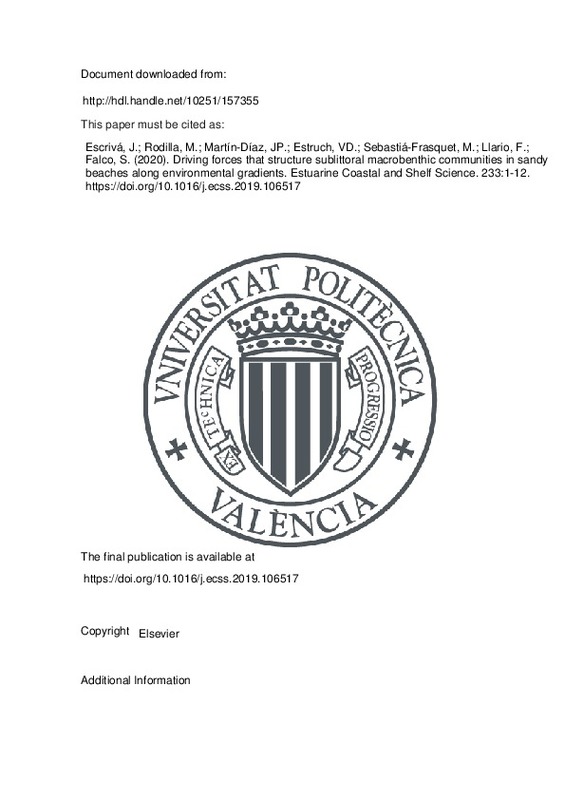|
Resumen:
|
[EN] Sandy beaches are very dynamic and changeable environments that present a wide variety of life forms, and, in some areas, high productivity. In the Gulf of Valencia (Western Mediterranean Sea, Spain) these areas have ...[+]
[EN] Sandy beaches are very dynamic and changeable environments that present a wide variety of life forms, and, in some areas, high productivity. In the Gulf of Valencia (Western Mediterranean Sea, Spain) these areas have endured an economically important shellfishery of clams (Donax trunculus and Chamelea gallina). In the Mediterranean, a sea with a notable oligotrophic character, rivers are particularly important because of the contributions of fresh water that carry nutrients and organic matter to coastal ecosystems. Consequently, close to the mouths of the rivers, it is possible to investigate the functions of physical, chemical and biological gradients on the macrofauna structuring of sandy beach communities. The objective of this study was to determine the response of sublittoral benthic communities to environmental variables in microtidal intermediate sandy beaches of the south of the Gulf of Valencia. Samples of benthic macrofauna, water and sediment were collected at 5 stations located in the sublittoral zone at different distances to freshwater sources, each one sampled at five depths, in three sampling campaigns. In general, the physicochemical and nutritional variables of water showed a spatial variation alongshore, and only a few variables (dissolved inorganic nitrogen, suspended solids and salinity) also had an across-shore variation. This variability was due to the different freshwater contributions. The sediment variables (mean grain size and organic matter) presented clear patterns related to depth. With respect to the macrofauna, positive relationships with depth were observed for the total density, density of bivalves, polychaetes, crustaceans and C. gallina, while D. trunculus showed the opposite pattern. The proximity to freshwater sources, favoured a greater abundance of organisms. Regarding temporal variation, two very different phytoplanktonic compositions between winter and summer could be distinguished, while, for the macrofauna, differences in abundance were observed with maximum values in summer. The influence of freshwater discharges on the phytoplankton primary production will have an influence on the abundance of macrobenthic fauna, but after a time lag. By means of CCA analyses, it was found that the communities of benthic macrofauna were strongly influenced by physical factors such as mean grain size, as well as the nutritional variables (organic matter in sediment and microalgae in the water column) and the distance to the freshwater discharges. The identification of these variables is crucial in order to develop an adequate coastal management, paying special attention to the anthropogenic activities that may be modifying the environment and, therefore will affect the biocoenoses.
[-]
|
|
Agradecimientos:
|
This project was funded by Vicerrectorado de Investigacion de la Universitat Politecnica de Valencia in the framework of the research project: "Influencia de factores fisicos, quimicos y nutricionales en la distribucion ...[+]
This project was funded by Vicerrectorado de Investigacion de la Universitat Politecnica de Valencia in the framework of the research project: "Influencia de factores fisicos, quimicos y nutricionales en la distribucion espacio temporal de la macrofauna bentonica del sublitoral de playas arenosas", Reference No. SP20120678. The authors would like to thank Dr Omar Defeo and the anonymous reviewer for their comments and suggestions that substantially improved the manuscript
[-]
|







![PDF file [Pdf]](/themes/UPV/images/pdf.png)
![[Cerrado]](/themes/UPV/images/candado.png)


